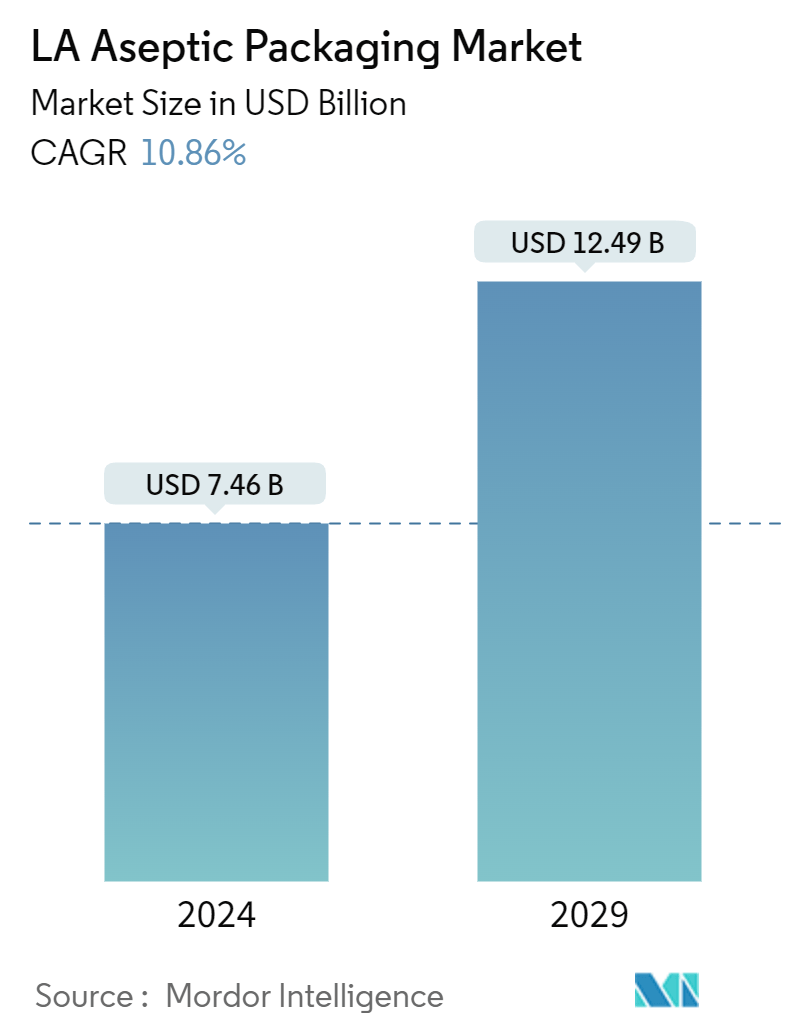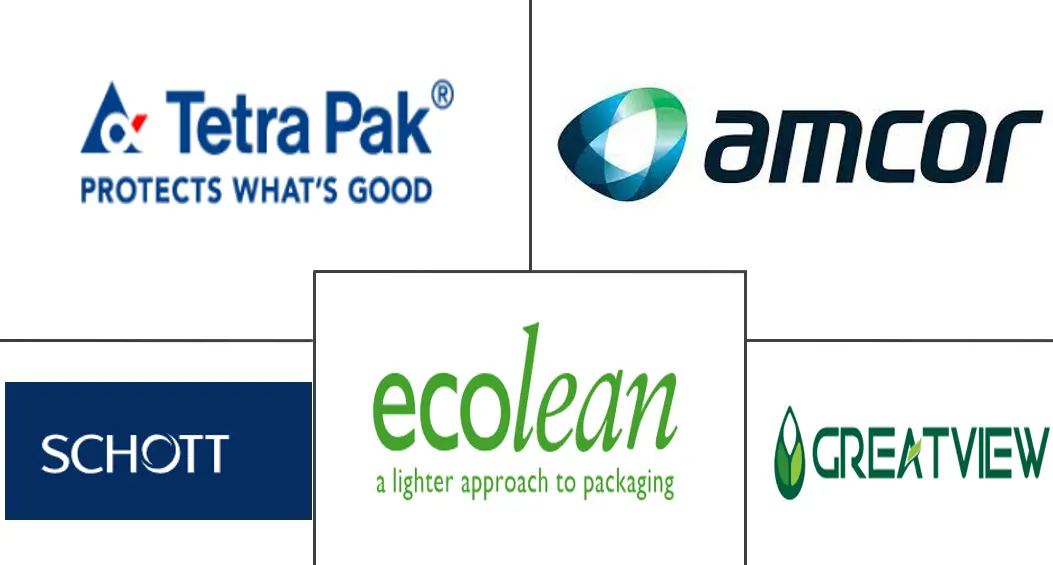Market Size of Latin America Aseptic Packaging Industry

| Study Period | 2019 - 2029 |
| Base Year For Estimation | 2023 |
| Market Size (2024) | USD 7.46 Billion |
| Market Size (2029) | USD 12.49 Billion |
| CAGR (2024 - 2029) | 10.86 % |
| Market Concentration | Medium |
Major Players
*Disclaimer: Major Players sorted in no particular order |
Latin America Aseptic Packaging Market Analysis
The LA Aseptic Packaging Market size is estimated at USD 7.46 billion in 2024, and is expected to reach USD 12.49 billion by 2029, growing at a CAGR of 10.86% during the forecast period (2024-2029).
- Latin America offers excellent potential in the market studied as a region that produces a lot of raw resources and food products. Rapid industrialization in countries like Brazil, Argentina, Columbia, and Mexico is driving economic growth. As in other continents, the use of new, more environmentally friendly technology is paving the way for the provision of reactions and solutions along the whole food chain to the trend of rising responsible and conscious consumption. These developments are most apparent throughout the processing and preservation stages when they assure quality and safety and extend the food's shelf life. Aseptic packaging is becoming increasingly popular as a safer and more profitable food packaging option.
- Consumers' preference for healthier alternatives is leading to a surge in investment in aseptic packaging despite the potential technical and cost issues associated with the formats. As aseptic designs become increasingly popular due to consumer preference for healthier alternatives, manufacturers are investing in packaging and fill technologies to meet this demand. In Brazil, product development is being driven by consumer preference for functional and healthier options. Dairy companies are focusing on installing aseptic fill machines to cater to the increasing demand for dairy-based products.
- In line with this, Shefa and Líder Alimentos, two Brazilian dairy companies, selected SIG as their preferred partner for supplying and installing aseptic fillers and packaging solutions. SIG is the provider of advanced aseptic fill technology in Brazil. It installed nine aseptic fill machines at production sites in São Paulo and Paraná, where the systems have already started operating.
- Ball Corporation announced it was expanding its operations in South America, landing in Peru with a new manufacturing plant in Chilca. After expansion, the plant will have a production capacity of over 1 billion beverage cans annually. Premiumization has been a critical growth driver for players in the alcohol space due to consumers' continued desire for refreshing and newer tastes and premium packaging. The companies in the industry have been focused on investing in crafting a diverse portfolio of global and specialty premium brands.
- Additionally, the growing demand for soft drinks and other non-alcoholic beverages in Mexico is expected to support the need for aseptic packaging in the forecast timeframe. For instance, according to the National Institute of Statistics and Geography (INEGI), the production value of flavored soft drinks in Mexico amounted to over MXN 3474.71 million (USD 207.05 million) in April 2023, compared to MXN 2811.06 million (USD 167.51 million) in February 2023.
- However, it is difficult to remove this material from packaging due to the presence of aluminum and polyethylene components in aseptic cartooning. To achieve accurate recycling (where materials are recycled to a previous stage of the production cycle without loss of quality), all the layers of Tetra Pak would need to be separated and reused to produce more Tetra Pak. Additionally, the availability of such machines is limited to certain players. Recycling requires a lot of equipment and inputs, such as water and energy, and many recycling centers do not have these. Such factors might hinder market growth.
Latin America Aseptic Packaging Industry Segmentation
The study tracks consumer demand based on sales of aseptic packaging products offered by various vendors operating in the global market. The study factors in the impact of geopolitical scenarios on the overall supply chain of the market. The study factors the prevalent base scenarios, key themes, and end-user vertical-related demand cycles.
The Latin American aseptic packaging market is segmented by products (cartons, bags and pouches, cans, bottles, and other products), application (beverage [ready-to-drink, dairy-based beverages, others], food [processed food, fruits and vegetables, dairy food, and others], and pharmaceutical), and country (Brazil, Argentina, Mexico, and Rest of Latin America). The market sizes and forecasts are provided in terms of value (USD) for all the above segments.
| By Product | |
| Cartons | |
| Bags and Pouches | |
| Cans | |
| Bottles |
| By Application | |||||
| |||||
| |||||
| Pharmaceutical |
| By Country*** | |
| Brazil | |
| Argentina | |
| Mexico |
Latin America Aseptic Packaging Market Size Summary
The Latin American aseptic packaging market is poised for significant growth, driven by rapid industrialization and increasing consumer demand for healthier and more sustainable food packaging solutions. Countries like Brazil, Argentina, Colombia, and Mexico are at the forefront of this expansion, leveraging their abundant raw resources and food production capabilities. The adoption of environmentally friendly technologies is enhancing the food supply chain, particularly in processing and preservation, ensuring quality, safety, and extended shelf life. Aseptic packaging is gaining traction as a cost-effective and safe option, with major manufacturers investing in advanced packaging and filling technologies to meet the rising demand. The market is also witnessing strategic partnerships and expansions, such as SIG's collaboration with Brazilian dairy companies and Ball Corporation's new manufacturing plant in Peru, further bolstering the region's aseptic packaging capabilities.
The market's growth is supported by the increasing popularity of convenience foods, ready-to-eat products, and the rising demand for organic and healthy options, particularly in Brazil. Aseptic packaging is becoming essential in the food and beverage sector, with major players like Tetra Pak, Amcor, and SIG Combibloc making significant investments. The Brazilian food industry, along with the pharmaceutical and medical sectors, is a primary consumer of aseptic packaging, driven by the need to extend product shelf life and ensure safety. Regulatory support and technological advancements are expected to propel the market further, with the demand for aseptic cartons, especially for dairy products, on the rise. The market is moderately consolidated, with key players focusing on innovation, mergers, and acquisitions to maintain competitiveness and expand their market presence.
Latin America Aseptic Packaging Market Size - Table of Contents
-
1. MARKET DYNAMICS
-
1.1 Market Overview
-
1.2 Industry Value Chain Analysis
-
1.3 Industry Attractiveness - Porter's Five Forces Analysis
-
1.3.1 Bargaining Power of Suppliers
-
1.3.2 Bargaining Power of Buyers
-
1.3.3 Threat of New Entrants
-
1.3.4 Threat of Substitute Products
-
1.3.5 Intensity of Competitive Rivalry
-
-
-
2. MARKET SEGMENTATION
-
2.1 By Product
-
2.1.1 Cartons
-
2.1.2 Bags and Pouches
-
2.1.3 Cans
-
2.1.4 Bottles
-
-
2.2 By Application
-
2.2.1 Beverages
-
2.2.1.1 Ready-to-Drink
-
2.2.1.2 Dairy-based Beverages
-
-
2.2.2 Food
-
2.2.2.1 Processed Food
-
2.2.2.2 Fruits and Vegetables
-
2.2.2.3 Dairy Food
-
-
2.2.3 Pharmaceutical
-
-
2.3 By Country***
-
2.3.1 Brazil
-
2.3.2 Argentina
-
2.3.3 Mexico
-
-
Latin America Aseptic Packaging Market Size FAQs
How big is the Latin America Aseptic Packaging Market?
The Latin America Aseptic Packaging Market size is expected to reach USD 7.46 billion in 2024 and grow at a CAGR of 10.86% to reach USD 12.49 billion by 2029.
What is the current Latin America Aseptic Packaging Market size?
In 2024, the Latin America Aseptic Packaging Market size is expected to reach USD 7.46 billion.

